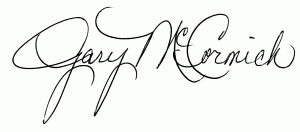This post is part of The Plank Center’s Legacies from Legends in PR Series that was begun in recognition of the 40th Anniversary of the Public Relations Student Society of America in 2007.
Following more than three decades of experience creating award-winning campaigns for corporate and government clients, Gary formed GMc Communications in 2016. Prior to creating his consultancy, he was director of corporate communications for Scripps Networks Interactive, parent company of cable networks HGTV, Food Network, DIY Network, Cooking Channel, Travel Channel and Great American Country. Before that, he supported the promotion of its home giveways – HGTV Dream Home, HGTV Urban Oasis and HGTV Smart Home; identified opportunities for reciprocal marketing for HGTV and DIY Network; and was the director of public relations for DIY Network and Fine Living TV Network. Joined Scripps after 17 years of public relations and public affairs support to a variety of federal government clients. Former Chair/CEO of PRSA, president of the PRSA Foundation and member of the PRSA board of directors. Co-chair of the Champions for PRSSA. Recipient of PRSA’s Ferguson Award (2006) and PRSA’s Pat Jackson Award (2015.)
One of the first things I ask every student who tells me they want to go into public relations is, “Do you have the personality for PR?” In this light, what does it take to be successful at public relations? Here is my top 10 characteristics for success:
- Be Creative. In a competitive media marketplace, tried and true is the right way to go for crisis communication and investor relations. The practitioner who can see new opportunities and approaches will be the leader instead of the follower.
- Be Curious. Questioning how things work and why they’re done that way will serve you well. It helps to understand the inner workings to determine how to do it better, or how to deliver a stronger message that resonates with your objective.
- Be Competitive. Shy and retiring won’t get you into the next position to promote your client and brand. In business, there are limited opportunities to position yourself within the marketplace, and unless you understand and are willing to compete, you’re missing out. If you aren’t providing the opportunities, marketing is more than happy to step up and deliver the message.
- Be a Storyteller. People remember the facts better and react more favorably to a story than to a list. The human element of any issue also is more compelling than the financial. Focus your public relations on the story, and more often than not, you’ll find success.
- Build a Network. A public relations professional is only as good as his/her contacts–media, vendors and peers. Sitting in an office won’t get you where you need to be if you want to impact your business. Reach out, find a mentor and become a part of the community, the industry and the profession. Every person you meet provides unique experiences and additional expertise. Remember, too, that giving brings greater returns, so you should always be looking to help others before you can expect them to help you.
- Be a Complete Communicator. While it’s widely accepted that writing is an essential skill, don’t underestimate the value of being a good speaker and using visuals/pictures to convey your message. Use every tool in your toolkit to communicate.
- Put Ethics First. Protect your reputation, which is the biggest asset for any professional. Adhering to the highest ethical standards will have better returns on your career than any educational degree or client campaign. Without it, you may no longer be in business.
- Look/Listen/Learn. Much of what makes a successful practitioner is the ability to evaluate interactions and relationships to identify what’s not being said. Many times it’s who is not talking and why, or who is not interacting with whom and why, that makes the difference. To manage relationships and affect change, the biggest job is sometimes the research and background to explain how and why a problem has arisen. Otherwise, you run the risk of “misdiagnosing” the problem.
- Avoid Ethnocentricity. Viewing other cultures or interactions from the perspective of your own heritage limits the diversity of ideas and opinions that elevate your ability to better communicate and enhance change. Diversity is not about representation, but more about understanding how each of us filters and interprets based upon our own experiences and values. By attempting to limit judgment and allow for understanding alternative perceptions and preferences, a practitioner can better serve a company or client and communicate more effectively.
- Embrace Change. Become a change agent, supporting and understanding the challenges of change within an organization. Most people are uncomfortable with change, but our profession is based on helping people change actions, attitudes, opinions or beliefs. In this rapidly changing marketplace, the one leading the change will be the true public relations professional.
Published: 2007
- Biography
- Plank Legends & Leaders Interview
- Speech: PRSA’s Patrick Jackson Award for Distinguished Service
- Webinar: Building Your Brand and Finding That First Job
- Infographic: 10 Characteristics for Success in PR
- Infographic: 10 Survival Tips for Your Media Pitch
- News: Formation of Diversity & Inclusion Committee
